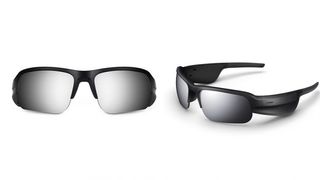You can trust Coach
Before I tested them, I considered the Bose Frames Tempo a hard sell. People have been getting on very well wearing both sunglasses and headphones, so I can’t imagine why anyone would pay £240 to consolidate those items into a package that is in some ways less convenient, in that they can only be used when it’s bright enough for sunglasses.
After using the Tempo glasses for a week of running and cycling, I still think they’re a hard sell – although the tech itself is impressive and outperformed my expectations. The glasses are comfortable and surprisingly lightweight, and the sound is not completely terrible.
That sound is delivered via two speakers built into the frame of the glasses. The Tempos do not use bone conduction tech like Aftershokz’s headphones to play music while leaving your ear free – they effectively just play sound near your ears, though they direct that sound precisely.

While there is little bass to speak of, the sound was powerful and crisp, and I found it better than the quality of audio you get from bone conduction headphones. Even when cycling on busy roads my music and podcasts were clear and fairly easy to hear, and I was surprised that when running on a very windy track that wind didn’t affect the sound at all.
The extra awareness you get from having your ears clear is something I only really appreciated when cycling – I’m happy with in-ear buds when running, even by busy roads – but it would also mean these glasses are probably going to be allowed in running events where most headphones are banned. Even if not, people aren’t going to know they’re not just sunglasses, right?
Well, they might, because sound does leak from those speakers. If you crank up the volume those around you will hear your music quite clearly. This is not a problem on most runs and cycles, where you’re passing people quickly, but if you’re in a group of people for the entirety of a marathon, say, you may well rile someone.
The Tempos are not the only pair of audio sunglasses made by Bose, but they are the set designed for sports. They are IPX4 rated, so they’re sweat- and water-resistant, and the lightweight frame comes with three sizes of swappable nose pads to ensure a secure fit.
I was impressed by the fit. The glasses didn’t move around during runs and rides, and they didn’t feel different from a normal set of sunnies really, despite the frame’s bulky sides. They weigh just under 50g – heavier than a normal set of sports glasses, which will be more like 30g, but I didn’t notice the difference when running.
The Frame Tempo glasses last eight hours on a single charge and take an hour to fully charge from empty. You also get a voice notification of how much battery is left on the glasses each time you turn them on. Eight hours is pretty good for the size and weight of the frames, and will last you most long runs and rides.
See related
- The Best Running Headphones Of 2021
- The Best Running Sunglasses
- Bose Sport Earbuds Review: The Most Comfortable Sports Headphones
There is one button on the right side of the glasses which you hold to turn them on and off, press to play/pause audio, double press to skip forward, and triple press to skip back. You can use the touch panel on the right side of the frame to activate your voice assistant by holding a finger on it, and control the volume by swiping forwards to turn it up, backwards to turn it down.
The button control works well during exercise, but the touch panel is a little more fiddly. Also when cycling with the glasses on I found the strap of my helmet would keep activating the voice assistant on my phone, which was annoying.
Also annoying are the many prompts to use a Bose app to pair the glasses to your phone, setting up an account in the process. This app is needed to update the firmware from time to time but otherwise it’s redundant – there are no EQ settings or extra features – so it’s a largely useless process that takes time and requires your personal details.
You get one set of lenses when you buy the Tempo glasses, which are mirrored black polarised. There are other lenses available for £30 that suit different conditions, including low-light lenses for twilight outings, and ones that work better on trails (pictured, below), helping you to pick out things like roots or other hazards on your path.

I found that the black lenses were not ideal running on trails under tree cover even on bright days. If you wanted to maximise your use of the Tempos you’d probably need to at least pick up the low-light lenses as well.
Which returns me to where I began – are they going to be all that useful? I probably wouldn’t use them on most of my runs, simply because sunglasses are so infrequently needed in the UK, so I’d need to get dedicated headphones as well.
Even if you do use sunglasses all the time, you can get headphones that sound so much better than these for a quarter of the price. Or even less. Pair those headphones with a great set of running-specific sunglasses and you’ll still have a fair chunk of change from the £240 you’d spend on the Bose Frames Tempos.
The open-ear design of them does allow for more awareness, but if that is the deciding factor for you consider the cheaper Aftershokz bone-conduction headphones. They might not sound as good but they achieve the same effect for a lot less money than the Frames Tempos.
The Bose Frames Tempos achieve exactly what they set out to – they are sunglasses that play music – and in fairness they exceeded my expectations for comfort and sound quality. So if the idea of audio sunglasses ticks all the boxes for you – perhaps you run or ride in the sun every day on busy roads – they will fit the bill. But they are still a niche product, and such an expensive one that they’re hard to recommend.
Buy from Bose | £239.95

Nick Harris-Fry is a journalist who has been covering health and fitness since 2015. Nick is an avid runner, covering 70-110km a week, which gives him ample opportunity to test a wide range of running shoes and running gear. He is also the chief tester for fitness trackers and running watches, treadmills and exercise bikes, and workout headphones.

